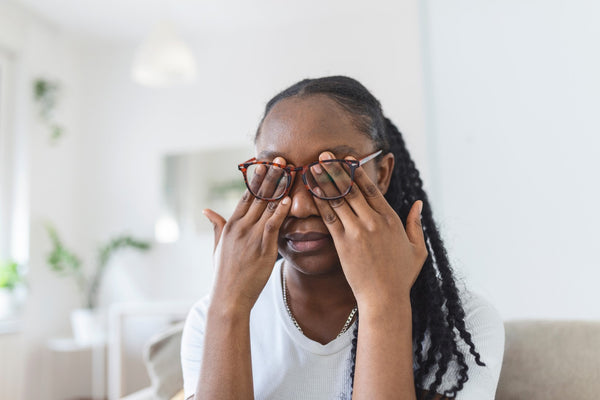Dry eyes, a common condition affecting millions worldwide, disrupts the delicate tear film that keeps your eyes lubricated and healthy. Dry eye is a common condition affecting millions of individuals worldwide.
While it might seem like a minor inconvenience, the discomfort and potential damage to your eyes make it essential to understand the symptoms, causes, and treatment options for dry eyes.
Understanding Dry Eyes
Our eyes rely on a complex system for tear production and distribution. Three distinct layers work together: an oily layer to prevent evaporation, a watery layer for lubrication, and a mucus layer for spreading. This complex structure ensures the eyes stay lubricated, nourished, and protected.
Dry eye, also known as Keratoconjunctivitis sicca (KCS), occurs when the eyes do not produce enough tears or when your tears don't provide enough lubrication for your eyes. It disrupts the harmony of our eye's layers, leading to insufficient or poor-quality tears. The eye dryness can cause many symptoms, including irritation, burning, and blurred vision.
Symptoms of Dry Eyes
The signs of dry eye can range from mild irritation to significant discomfort, affecting the quality of life and overall eye health. Hence, recognizing the symptoms of dry eyes is the first step in addressing the issue. The common dry eye symptoms include:
- Gritty or sandy feeling in the eyes
- Burning or stinging sensation in the eyes
- Redness and irritation
- Blurry vision, especially during prolonged screen time
- Excessive watering, ironically caused by the eye's attempt to compensate for dryness
- Light sensitivity or photophobia
- Difficulty wearing contact lenses
If you are experiencing any of these symptoms, seeing an eye doctor for a proper diagnosis and treatment plan is essential.
Causes of Dry Eyes
Various factors contribute to the development of dry eye syndrome, disrupting the delicate balance in the tear film. So, understanding them is crucial for effective dry eye disease control.
One significant cause of dry eyes is ageing. As individuals get older, tear production tends to decrease, and the composition of tears may change. This age-related decline can result in insufficient lubrication of the eyes, leading to dryness and discomfort.
While ageing is a major contributor, medications like Antihistamines, decongestants, antidepressants, and some blood pressure medications can trigger dry eye causes as well.
Several underlying health conditions can be linked to dry eyes, i.e., arthritis, diabetes, and thyroid disorders may affect tear production or quality, exacerbating dry eye symptoms.
Hormonal changes, particularly in women, can also play a role in developing eye dryness. Fluctuations in hormones due to pregnancy, menopause, or the use of oral contraceptives can impact tear production and quality, making women more susceptible to this condition.
Environmental factors are another key contributor. Dry or windy climates, high altitudes, and air conditioning or heating systems exposure can accelerate tear evaporation, leaving the eyes inadequately moistened.
Prolonged screen time is a modern concern, as it often leads to reduced blink rates, hindering the distribution of tears and contributing to dry eye symptoms. Lastly, lifestyle habits like smoking, excessive caffeine intake, and contact lens use can exacerbate eye dryness.
Diagnosis and Treatments of Dry Eyes
If you suspect you have dry eyes, seeking professional consultation is essential for accurate diagnosis and personalized dry eye treatment. Eye care professionals may conduct a comprehensive eye exam, including evaluating the quantity and quality of tears produced. They may perform tests like tear film evaluation, Schirmer's test, and fluorescein staining to assess the severity and type of dry eye.
However, the treatment options vary depending on the cause and severity. Some common approaches include:
- Artificial tears / Eye Drops: These lubricating drops help replenish the tear film.
- Prescription medications: Medications like Cyclosporine or Lifitegrast can stimulate tear production.
- Punctal plugs: Tiny inserts in the puncta block the tear ducts, allowing tears to stay on the eyes longer.
- Lid hygiene: Regular cleaning of the eyelids is an effective eye dryness therapy that helps remove debris and improve tear gland function.
Home Remedies For Dry Eyes
While not a substitute for professional diagnosis and treatment, several home remedies for dry eyes can offer comfort and manage mild dry eye symptoms:
- Warm compresses: Apply a warm washcloth to your closed eyelids for 10-15 minutes to improve blood circulation and unblock meibomian glands.
- Avoid irritants: Limit exposure to smoke, wind, and dry environments.
- Blink more consciously: Especially when focused on screens, make an effort to blink regularly and consistently.
- Omega-3 supplements: Consider incorporating omega-3 fatty acids in fish oil supplements or certain foods into your diet.
- Eyelid massage: Gently massage your eyelids to stimulate tear gland function.
- Reduced screen time: Practice the 20-20-20 rule during prolonged screen use.
- Eye protection: Wear protective eyewear to shield the eyes from harsh winds and dry conditions. You can explore various eyeglasses online, including kids eyeglasses, stylish eyeglasses for women, and eyeglasses for men.
- Hydrate eyes: Use a humidifier to add moisture to the air and drink plenty of water to stay well-hydrated and improve tear quality.
It's advised to discuss an eye dryness remedy with your eye doctor before trying them to ensure they are safe and effective for your condition.
Conclusion
Though a common condition, dry eyes shouldn't impact your comfort or vision. By understanding the causes and seeking appropriate treatment at the right time, you can effectively manage the symptoms and enjoy healthy, lubricated eyes. From lifestyle adjustments to medical interventions, a multifaceted approach is often necessary to manage dry eyes effectively.
If you experience persistent symptoms, seeking professional advice from certified opticians is crucial to determine the underlying cause and develop an appropriate treatment plan. By prioritizing eye health and adopting preventive measures, you can ensure your eyes remain comfortable and well-nourished.



